Stories
Moana Markings
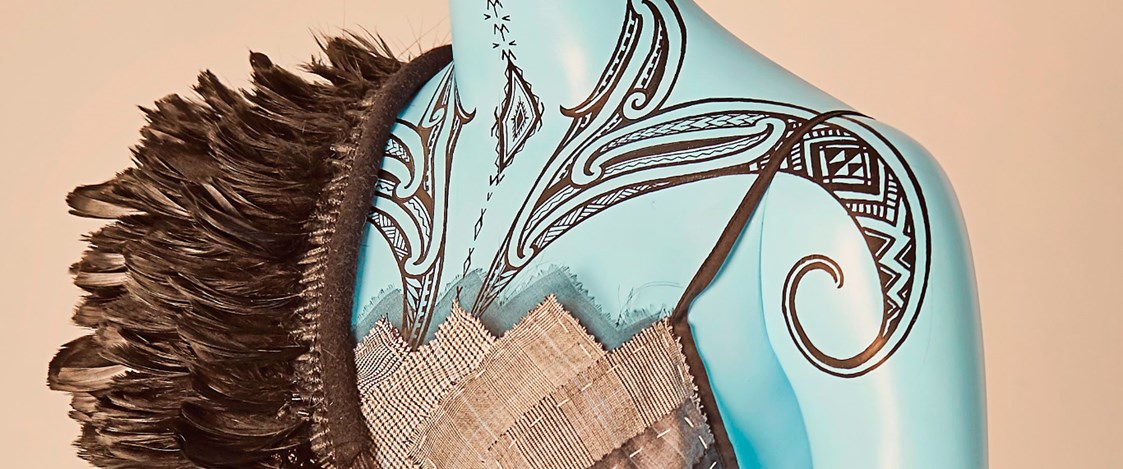
How we dress our bodies helps us mediate the space between our internal world and the world outside. We use our clothing, hairstyles, make-up, accessories and body modifications such as tattoo and piercing to fashion our identity. The language of dress is complex and the idea that one should be dressed properly is a concept that has currency across cultures.
The parameters of 'proper' however vary depending on location and the role we have to play in the performance for which we are dressing; a day at school or in the office, an interview or a presentation, whether among strangers or friends. In the Western dress vocabulary, for example, proper attire for a black tie event is a tuxedo, black shoes, white shirt and black bow tie for men and for women it is a long dress with the expectation that the hair will also be 'dressed' and appropriate ornamentation will be worn. Most cultures have dress requirements for particular social occasions, which might also include necklaces, armbands, earrings or head ornaments, and extend to the application of scented oils or perfumes, decoration wrought in paint and pigments, particular hairstyles, hair bleaching or hair covering and other preparations including washing and grooming. Sometimes, too, being properly dressed might include body modification such as tattooing and piercing. For this reason we have chosen to include adornment and tattoo in our assemblages for Moana Currents.

Tyla Vaeau says her tatau for Moana Currents reminds us that as a people of Te Moana Nui a Kiwa we walk every day with our ancestors.. Photo by Tatiana Harper, courtesy of Te Uru Gallery.
The current popularity in Aotearoa and overseas of tattoo, or tatau as it is called in Sāmoa and Tahiti signals a vitality that is reinvigorating this ancient practice. There is a flourishing community of tattoo artists who are actively engaged in the research and revitalisation of moana tattoo and we invited six of them; Julia Mage'au Gray, Moko Smith, Pip Hartley, Tyla Vaeau, Vaimaila Urale and Victor Webster, to participate.
Tattoo in this region arrived with the ancestors who ventured out from South East Asia some 3500 years ago, navigating their way via the chain of islands along the ocean rim into the great expanse of Te Moana nui a Kiwa. They settled the small scattered islands of the central, eastern and southern territories of the ocean. They brought their ground-stone adzes, shell artifacts and flaked-stone tools of obsidian and chert, and their signature decorated ceramics, commonly called, Lapita pottery, after a site in New Caledonia where it was found. Motifs that express the knowledge, skills and ingenuity of the ancestors are featured on the distinctive pottery remnants and are at the heart of the shared design language seen on cloth, carved in wood and stone and etched into skin.

This 'Lapita face' shard was found at the Nenumbo site in the Solomon Islands and is thought to date back to 1000 BC. Courtesy of the Anthropology Photographic Archive, University of Auckland.
But as Sean Mallon, researcher and co author of Tatau: A Cultural History of Samoan Tattooing, is at pains to point out, the story of tattoo is one of both continuity and of disruption. Tattoo is dynamic; its practice, symbols and meanings have changed and continue to change in response to internal and external influences from one generation to the next. Tattoo's survival and current revival is a consequence of this openness and its opposite, a staunch protection and perpetuation of tatau practices by Samoan tufuga tā tatau (tattoo masters) in the face of Christian prohibition.
Shared Moana mythologies and oral accounts record a long history of inter-island trading networks, which included the sharing of tattoo knowledge. A Samoan tatau origin myth, for example, tells of twin sisters, Taema and Tilafaiga, who go to Fiji to collect the tools and knowledge of tattoo. In Tonga members of the royal house, unable to be touched by their own people, employed the services of Samoan tufuga tā tatau for the creation of their tattoos. The naturalist on the Endeavour, Joseph Banks, and many of Captain Cook’s sailors returned from their voyage in the South Seas marked with Moana tattoo, and Sean Mallon has documented a report from Aotearoa in the 1840s that describes an American prison escapee who had a tattoo, from his knee to his hip, acquired in Sāmoa. This history shows that Moana tattoo, in its diverse local iterations, was a dynamic, responsive, and shared cultural practice across the moana.
However the arrival of missionaries and colonists brought with them prohibitive laws around 'proper' dress and behaviour codes which meant that adopting aspects of European culture became a way to survive and function. For Māori and many other people of the moana, language and cultural practices such as tattooing suffered decline or were even abandoned altogether. In Sāmoa, despite the successful conversion to Christianity, the art and ritual of tatau did manage to survive and operate in parallel to the new religion, ensuring that the skills and knowledge were maintained and could be shared. It is the adaptability and openness to sharing of the Samoan tufuga tā tatau which has underpinned the renaissance of the art of tattoo across the moana and its distribution around the world.
All of the Moana Currents practitioners acknowledge their tohunga (learned person) and their tupuna (ancestors). Mokonui-a-rangi Smith, who trained under the tutelage of celebrated tattoo artists Croc Coulter and Inia Taylor, uses the uhi (traditional wood and bone tools of tā moko). He says, "In hitting the sticks together to place the ink under the skin, there is an immediate link to the past. The sound the tools make is the same sound our ancestors heard in their time, the bite of the bone teeth in the skin is the same feeling our ancestors felt in their time. In this process, there is a closing down of time and space."

A visitor at the Moana Currents exhibition opening considers Moko Smith's custom tā moko on a mannequin. Photo by Denise Baynham.
Pip Hartley is a tā moko artist who was guided on her path by tohunga and mentor Te Kura Te Wanikau Turoa. Using both uhi and tattoo machines she is sharing her knowledge of ancient symbology through contemporary indigenous markings. Having travelled extensively teaching and studying tattooing practices from places as diverse as Argentina and the Phillipines she established her own studio, Karanga Ink in Auckland. Pip's vision for this space is to "enable indigenous artists of Aotearoa and across the globe to express their cultural heritage and offer a platform to share knowledge, skills and cultural understanding."
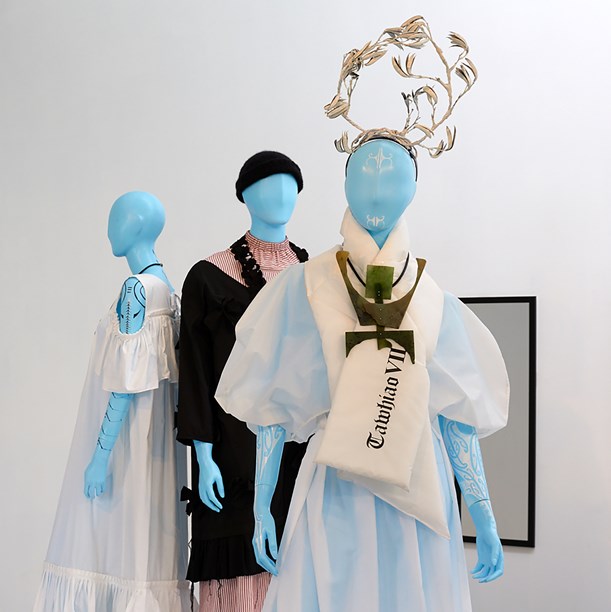
Pip Hartley is part of a new generation of tā moko artists who create individual and personal markings for their clients (mannequin in the foreground), while the mannequin on the left carries markings by Julia Mage'au Gray. Photo by Sam Hartnett, courtesy of Te Uru Galley.
The Karanga Ink studio also provides a platform for Aotearoa born Samoan contemporary tatau practitioner Tyla Vaeau. She has integrated her training at Elam School of Fine Arts with her understanding of the historical and cultural significance of the Samoan malu (female leg tatau) and the pe’a (male leg tatau) to create her own contemporary designs.
The ancient symbols used in tatau relate to family, place, navigation, journey and so on and she works with them on an everyday basis to connect people with their own heritage and identity, to tell their stories and to honour their own oral histories through the markings on their skin.

Tatau by Tyla Vaeau for Danielle Meredith, 2017. Photo by Niko Meredith.
Sāmoa is also the source territory for the forms and symbols used by multi media artist Vaimaila Urale but she extends that vocabulary by also including punctuation marks found on your keyboard, seamlesly combining heritage motifs with the contemporary digital space. Spanning a wide range of media including sand installations, tattoos, video, digital prints, ceramics and painting, Vaimaila is consciously engaging within the continuum of knowledge systems and patterns unique to the Moana. The opportunity to be part of Moana Currents, offered a new layer of meanning through her familial connection, with the designer of Overstayer label, Bill Urale aka King Kapisi. Bill is her younger brother and her creative response to the patterns on the Overstayer shirt was to talk to these patterns. Her 'tattoos' are markings on the mannequins legs, made with local sand which she has anchored with a patterned sand installation at the base of the blue mannequin.
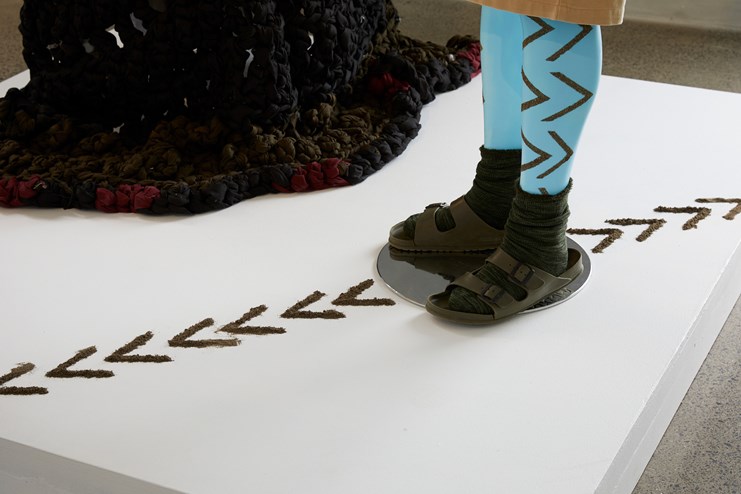
Vaimaila Urale's tatau is all about connections. Vaimaila is Bill's sister. The work is anchored in sand collected from the Manukau Harbour, visible through the adjoining window. Photo by Sam Hartnett courtesy of Te Uru Gallery.
The wearing and sharing of moana tattoo, is a fiercely contested zone, raising issues of cultural property, appropriation and permission. Who can receive a Māori tattoo or a Samoan tatau and is it authentic if it is a machine tattoo rather than one applied with hand tools? Does the tattoo artist need to be indigenous? These dilemmas have led to some innovative thinking and a sort of secularisation within the form. For Samoan tatau that freedom can be found in the taulima, a tattoo armlet usually worn around the bicep, which can be personalised by the wearer and does not carry the cultural and ritual significance essential to the giving of pe’a or malu.
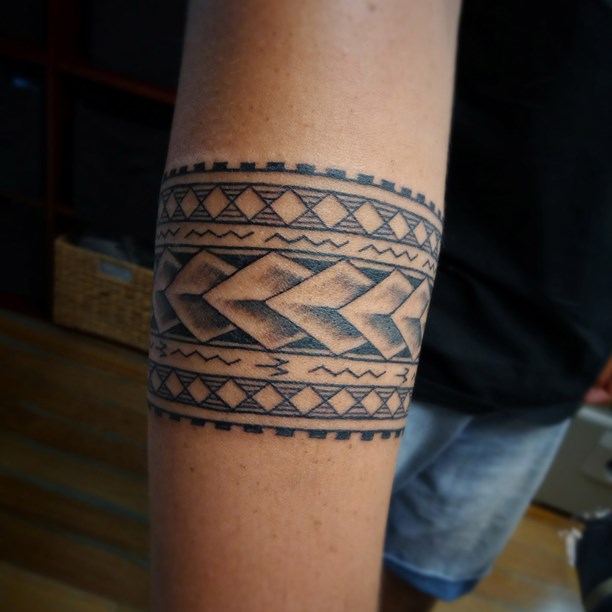
Taulima by tatau artist Tyla Vaeau, 2017.
Within Māori tattoo practice the temporal form has been given another name, kirituhi, meaning ‘drawn skin’. This distinguishes it from 'tā moko', Māori tattoo, and allows for the application and modification of motifs with a Māori inflection, without requiring genealogy, and so it is available to be worn by anyone. The creation of this sort of distinction has allowed Aotearoa tattoo artist Victor Webster to be commissioned to create a Moana-inflected tattoo design on a t-shirt for Japanese designer Junya Watanabe’s Comme des Garçons SS 2019 collection. Apprenticed in Auckland to Inia Taylor, Croc Coulter and Calen Paris of Moko Ink, a Māori art tattoo studio. Victor draws inspiration for the motifs he uses from that training, from his knowledge and travels around Aotearoa, Asia, Polynesia and Micronesia and from nature. He says, "It may be a simple repetition you see in a leaf or a fern. I think those connections to pattern and nature are always a reoccurring theme in my work."
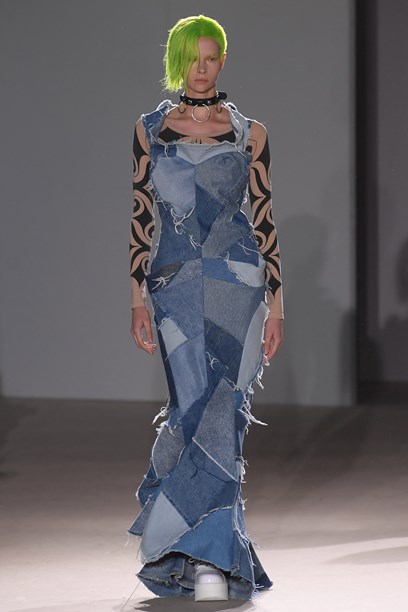
Junya Watanabe Comme des Garçons S/S 2019collection ink tattoo top designed by New Zealand tattoo artist Victor J Webster. Courtesy of The Brand.
Moana Currents envisages our ocean as expansive and inclusive, connecting all that it touches and in relation to tattoo that encompasses the skin markings worn by women in Papua New Guinea. Still evident today on the bodies of older women it is a practice that is being revitalised in Aotearoa by dancer, choreographer, photographer, film-making and now tattoo artist, Julia Mage'au Gray. Of Papuan and Mekeo heritage she picked up the hand poking and hand tapping tools to help women be 'properly' dressed. In Papuan culture to be tattooed is to be covered and what you wear is part of the language that identified you. Her markings for the Dru Douglas garment make it complete.
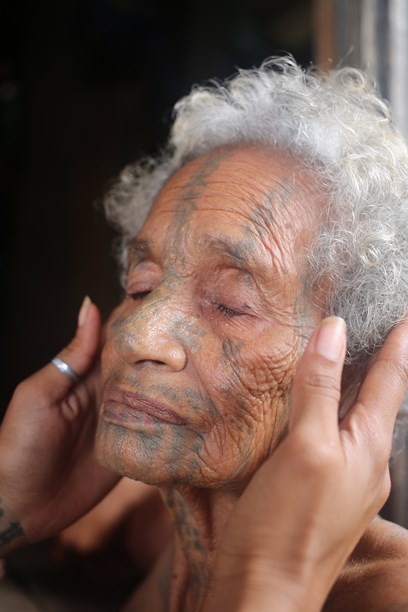
Photo courtesy of Julia Mage' au Gray, still from her documentary film Tep Tok: Reading Between Our Lines.
It is in the nature of culture to be dynamic, to change and adapt in order to survive, and recent decades have seen major efforts invested towards reviving languages and cultural traditions. Our Moana Currents artists are all contributing to that revival and are living proof that tattoo is an open practice. They embody and embrace the moana concept of vā, which frames the interrelationships between cosmology, nature and society as connected across time and space. They acknowledge what has gone before, how it intersects with the present and how it makes new connections that can relate and bind people and things together. They travel with their work all over the world, transferring, transforming and sharing the cultural ideas and customs of moana tattoo across new geographies.
Text by Doris de Pont. Banner image of tattoo by Pip Hartley and Tyla Vaeau @ Karanga Ink
Published October 2019.